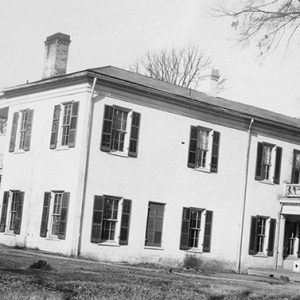calsfoundation@cals.org
Absalom Fowler (1806–1859)
Absalom Fowler was a prominent attorney and government official in early Arkansas. He was a leading figure in the transition of the area from territory to state, while also playing a major role in the development of Little Rock (Pulaski County).
Absalom Fowler’s early life is enshrouded in legend. The most reliable reports indicate that he was born in 1806 in Madison County, Kentucky, to Thomas and Alethia Fowler. Almost nothing is known about his early life, but it appears that he arrived in the Arkansas Territory by the mid-1820s with little more than the clothes on his back. Parts of his legend say that the penniless Fowler actually walked from Memphis, Tennessee, to Little Rock with all his possessions in a saddlebag. Whatever the exact truth surrounding his arrival in Arkansas, he soon established himself as a successful lawyer. Too, he quickly became a respected member of the community as he turned some of his early legal earnings into a small fortune in land speculation.
His legal career flourished, and he served as prosecuting attorney for the Arkansas Territory from 1829 to 1830. In 1833, Fowler joined in a partnership with respected and politically connected attorney Robert Crittenden, and when Crittenden suddenly died in 1834, he left the practice to Fowler. That same year, Fowler married Elvira Boswell; the couple had no children.
Fowler served as the president of the Arkansas Bar Association in the 1830s and was a representative from Pulaski County in the Territorial Legislature in 1835. The following year, while serving as a delegate to the state Constitutional Convention, he chaired the Select Committee that developed the compromise that resulted in the convention’s ultimate adoption of a bicameral legislature.
As a two-party political system developed in Arkansas, Fowler became a leader of the Whigs. Running as the party’s candidate for governor of the new state of Arkansas in 1836, he lost the election to Democrat James Conway by 2,000 votes. Still determined to serve, he was a member of the Arkansas General Assembly in 1838, and he ran as the Whig candidate for Congress in 1840. Although his candidacy was unsuccessful, following the Whig presidential victory in 1840, Fowler was appointed U.S. district attorney for the state in 1841. He held that post until 1843. After the death of his first wife in 1842, he married Frances Lewis on May 25, 1843.
Fowler continued to be involved in politics, serving again in the state legislature in 1844 and 1845, although some observers said that over the years the formerly energetic, self-made man became embittered by his losses to the Democrats. After running unsuccessfully as the American Party (a.k.a. Know-Nothing Party) candidate for Congress 1856, he became somewhat withdrawn in the years before his death in 1859.
Fowler also made a mark in the state militia. He served in a regiment of the territorial militia in the 1830s. Later in the decade, major concerns arose over possible attacks by Native Americans against an undefended Arkansas, a result of the deployment to Florida of Arkansas soldiers to fight in what became known as the Second Seminole War, a conflict that predated the Trail of Tears. Fowler was named a colonel of his battalion. He and his men were posted at Fort Towson on the Red River in Indian Territory (now Oklahoma), and from that base they engaged in scouting missions. When the war ended in 1837, army troops returned to Fort Towson, and Fowler and his battalion returned to Arkansas.
As one of Little Rock’s leading citizens, Fowler also left an indelible mark on the city in the Fowler House, which was listed on the National Register of Historic Places on June 4, 1973. The two-story brick structure, built by Fowler around 1840, featured a hip roof, and the Ionic-column-supported front portico was topped by a balustrade. It was further distinguished by a double row of dentil molding, giving it a checkerboard appearance. Fowler’s first wife, Elvira, died barely two years after the house was completed. Fowler also was an early member and supporter of the Antiquarian and Natural History Society of Arkansas, an organization begun in the state’s infancy with the purpose of preserving Arkansas artifacts and history.
He continued to be a leader of the state bar until his death on June 4, 1859, in Little Rock. Fowler is buried in the city’s Mount Holly Cemetery.
For additional information:
“Absalom Fowler.” Trail of Tears through Arkansas. Sequoyah National Research Center, University of Arkansas at Little Rock. http://ualrexhibits.org/trailoftears/people/absalom-fowler/ (accessed August 25, 2020).
“Absalom Fowler House.” National Register of Historic Places nomination form. On file at Arkansas Historic Preservation Program, Little Rock, Arkansas. Online at http://www.arkansaspreservation.com/National-Register-Listings/PDF/PU3142.nr.pdf (accessed August 25, 2020).
Hallum, John. Biographical and Pictorial History of Arkansas. Vol. 1. Albany: Weed, Parson’s and Company, Printers, 1887. Relevant section online at http://files.usgwarchives.net/ar/state/bios/fowlera.txt (accessed August 25, 2020).
Ross, Margaret Smith. “Absalom Fowler and His Home.” Pulaski County Historical Review 5 (June 1957): 1–22.
William H. Pruden III
Ravenscroft School
 Law
Law Louisiana Purchase through Early Statehood, 1803 through 1860
Louisiana Purchase through Early Statehood, 1803 through 1860 Military
Military Fowler House
Fowler House  Fowler House
Fowler House 




(2020) I believe that my 3rd great-grandparents (prior to their marriage) lived with Absalom Fowler. They are listed with him in the 1850 census. My great-great-great-grandfather was also an attorney and I believe he was in the employ of Mr. Fowler. My great-great-great-grandmother is my Arkansas mystery. She’s Mary Boswell, the niece of Elvira Boswell, and was cared for by Boswell and Fowler at some point in her life.
I’m about to retire as a school teacher and want to go back to UCA and study Arkansas history to see if I can unlock this puzzle. I’ve been trying for more than twenty years. This all sounds so interesting!